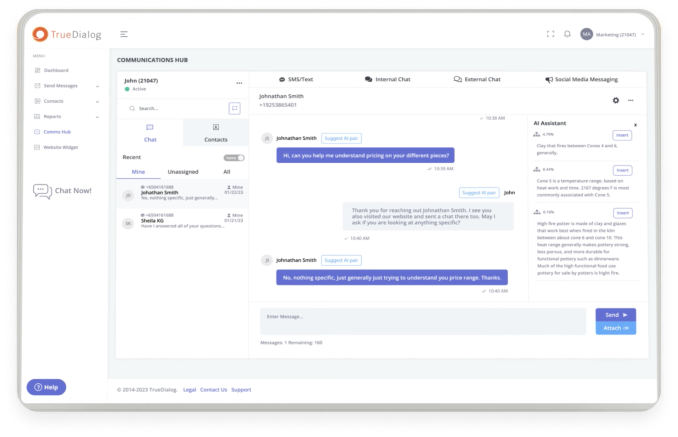What Is a Shared Short Code?
If your company already uses shared short codes to communicate with prospects and customers, you likely know exactly what they are. For those who may need a refresher or never gave them much thought, we’ll bring you up to speed.
Unlike a regular 10-digit phone number (or “long code”), an SMS short code is only five or six digits and used for texting customers versus calling them. Short codes are a great way to send mass text messages.
The FCC says, “Short codes and long codes are analogous to phone numbers; the code determines to whom the message is sent and how the message is routed. Short codes are rented to the public by the Common Short Code Administration (“CSCA”). Any entity that wishes to operate a service based on a short code must first lease the short code from the CSCA. Then the entity must ask every wireless provider to recognize and route messages using that code to the service provider.”
We’ve all received these texts, typically from organizations sending reminders, coupons, delivery or pickup times, alerts, or some other transactional or promotional message. The texts always ask us to type in a keyword to opt-in for future messages or participate in a marketing campaign. The CSCA requires service providers to allow subscribers to accept or decline these messages to limit spam.
Related: Long Code vs. Short Code Texting: Which is Right for Your Business?
The keyword does more than just give the recipient a way to join. When used for marketing purposes, SMS short codes enable the sending company to track the success of their campaigns. Each keyword can be unique to the campaign, making it easy to see which short code messages resonate with the intended audience.
Short Codes
A shared short code is a type of short code that thousands of organizations share to text their own customers. Companies often choose to use the same SMS short code to message customers because it is less expensive than having a private short code.
Many service providers, such as AT&T and Verizon, allow SMS short code services but not for long. As of June 1, 2021, all major wireless carriers will eliminate shared short codes entirely.
Why Are Shared Short Codes Going Away?
The termination of shared short codes is primarily intended to reduce customer complaints about spam and unwanted text messages. Carriers are in agreement that supporting shared short codes is labor-intensive and cost-prohibitive. Service providers are looking for ways to decrease spam traffic to protect consumers and meet customer needs.
There is also the issue of accountability and tracking. It is difficult for carriers to know precisely who is responsible for any messaging on shared codes.
One of the biggest issues with shared short codes is the fact that the carriers and CTIA state that no two-way messaging is allowed on shared codes. Shared short codes, therefore, are only effective for one-way conversations, making them more akin to spam.
In an effort to reduce spam, carriers are replacing shared short codes with 10DLC (10-Digit Long Code) messaging that ties messages to a specific organization via a unique phone-like number. Organizations that use this new type of messaging can send and receive messages on their assigned local number as well as use the number for voice calls.
Of course, this isn’t a magic bullet, and there are other options. For instance, while 10DLC is less expensive compared with shared short code services, it is still new. The velocity of messaging and delivery isn’t yet on par with SMS short code services. They require registration just like short codes but still have limits on volume per day per code, estimated to be around 2K – 4K per day.
Marketing teams will have no way to determine whether their audience received the message, removing the ability to keep customer data sets clean or understand the campaign’s true success rate. This may lead more organizations to consider other types of SMS short code services.
Short Code Options
Evaluating options other than shared short codes and 10DLC is also wise when it comes to gaining control over messaging and campaigns. Keep in mind that participating organizations and bad actors sometimes misuse the shared short code, causing the service provider to block the code for everyone. You also have to choose a keyword no other brand is using – not an easy feat when you consider tens of thousands of organizations can be using the same short code.
Organizations cannot control how others use the code, what would trigger a shutdown or when it may happen. This lack of control can cause serious interruptions in service, bring marketing campaigns to a screeching halt, and force organizations to switch to a new code to continue communicating with their audience.
Thankfully, you have options. SMS shared short code services may be going away, but that doesn’t mean you have to go the 10DLC route.
Dedicated Short Codes
Shared short codes are just one type of short code. Dedicated short codes come at different price points but enable your organization to have a private short code just for your brand.
You can use your dedicated short code for any SMS communications, marketing or operational. Because it is yours and yours alone, you don’t have to worry about a bad actor misusing it or having to constantly find a unique keyword for marketing campaigns.
There are two types of dedicated short codes: a vanity short code and a non-vanity short code.
Vanity Short Code
A vanity short code is one you choose yourself, like a vanity license plate for your car. You can select your five- to six-digit code based on availability. Organizations often lease vanity codes that are easy to remember or have specific brand meaning. For instance, Chipotle’s vanity short code is 888-222, a simple code anyone can recall.
A vanity short code is an excellent way to help your recipients recognize your brand when they see it come up on their mobile devices. It can also be easier for your recipients to remember when you ask them to text your SMS short code to participate in a marketing campaign. Of course, this kind of personalization comes at a price, costing approximately $1,500 per month.
Non-Vanity Short Code
With a non-vanity short code, the CSCA will select your short code at random. It will still be your own dedicated short code to lease, but you will not select the digits. You can expect to pay about half of the cost of a vanity short code. This is a smart choice if your organization doesn’t use short codes for marketing purposes or you are looking for the most cost-effective option.
A Short Code Service Provider Can Help
When searching for a vendor, look for a short code service provider with a comprehensive SMS platform. They will be able to help you build an ideal SMS platform for your specific business needs.
For instance, you may want both dedicated short codes and long codes, which you can use exclusively or in tandem to send high-volume text messages. The most advanced platforms allow short code texting for mass SMS messages and long code texting for personalized 2-way conversations – all in the same user interface. In fact, with the right provider, you can send millions of text messages, as well as enable multiple users to engage in two-way conversational texting at scale to improve customer experience.
Related: How Text Messaging Improves the Customer Service Experience
It is also a good idea to cut out the middleman and work with a provider that has direct carrier connections. By doing so, you will reduce potential points of failure and reliance on third parties to improve short code deliverability. You can also save money as these providers have lower costs and can provide enterprise volume pricing.
Want to learn more about all of the powerful features you can get with an SMS platform? TrueDialog’s industry-leading platform allows mass texting and personalized 2-way conversational messaging all in one seamless, easy-to-use interface. Learn why TrueDialog is a Capterra top-rated SMS software platform.






